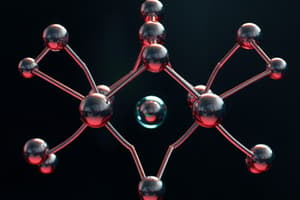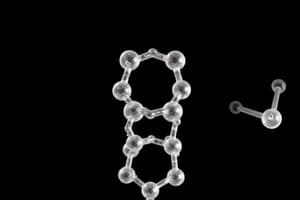Podcast
Questions and Answers
Why is it advantageous for boron to remain electron deficient?
Why is it advantageous for boron to remain electron deficient?
- To prevent the formation of inappropriate charges. (correct)
- To enhance the strength of its sigma bonds.
- To increase its electronegativity significantly.
- To form more stable negative charges.
What is the main characteristic of tautomers?
What is the main characteristic of tautomers?
- They are identical in all chemical properties.
- They represent the same molecular geometry.
- They can interconvert through the relocation of a hydrogen atom. (correct)
- They are resonating forms of a compound.
Which type of bond is characterized as a localized chemical bond?
Which type of bond is characterized as a localized chemical bond?
- Ion bond
- Hydrogen bond
- Sigma bond (correct)
- Pi bond
What defines the nature of conjugated π systems?
What defines the nature of conjugated π systems?
What property differentiates tautomers from resonance structures?
What property differentiates tautomers from resonance structures?
What role do π electrons play in double bonds?
What role do π electrons play in double bonds?
What occurs during tautomerization?
What occurs during tautomerization?
Why are π electrons more susceptible to electrophilic attack?
Why are π electrons more susceptible to electrophilic attack?
What characteristic of sp3 hybridized carbon prevents it from participating in π delocalization?
What characteristic of sp3 hybridized carbon prevents it from participating in π delocalization?
Which atoms can participate in π delocalization due to the presence of lone pairs?
Which atoms can participate in π delocalization due to the presence of lone pairs?
What is an essential feature of a Lewis structure to indicate a conjugated π system?
What is an essential feature of a Lewis structure to indicate a conjugated π system?
How do you determine atom charges in a molecule using Lewis structures?
How do you determine atom charges in a molecule using Lewis structures?
What is a significant consequence of π delocalization in organic compounds?
What is a significant consequence of π delocalization in organic compounds?
In the case of BF3, what is the total number of valence electrons?
In the case of BF3, what is the total number of valence electrons?
What defines the 'electron-deficient' structure of BF3?
What defines the 'electron-deficient' structure of BF3?
What happens to formal charges when comparing electron-deficient and octet-complete structures of BF3?
What happens to formal charges when comparing electron-deficient and octet-complete structures of BF3?
What occurs during the first step of a nucleophilic acyl substitution reaction?
What occurs during the first step of a nucleophilic acyl substitution reaction?
What is commonly referred to as an oxanion hole in enzymatic nucleophilic acyl substitutions?
What is commonly referred to as an oxanion hole in enzymatic nucleophilic acyl substitutions?
In nucleophilic acyl substitution reactions, what happens to the nucleophile?
In nucleophilic acyl substitution reactions, what happens to the nucleophile?
How does enzymatic stabilization affect nucleophilic acyl substitutions?
How does enzymatic stabilization affect nucleophilic acyl substitutions?
What is the role of an acid in a nucleophilic acyl substitution reaction?
What is the role of an acid in a nucleophilic acyl substitution reaction?
What type of bond formation is associated with peptide bond synthesis?
What type of bond formation is associated with peptide bond synthesis?
What is a characteristic of σ bonds compared to π electrons?
What is a characteristic of σ bonds compared to π electrons?
What is the main outcome of a nucleophilic acyl substitution reaction?
What is the main outcome of a nucleophilic acyl substitution reaction?
Which of the following statements is true regarding the tetrahedral intermediate in nucleophilic acyl substitution?
Which of the following statements is true regarding the tetrahedral intermediate in nucleophilic acyl substitution?
What is the significance of the p orbital in sp2 hybridization?
What is the significance of the p orbital in sp2 hybridization?
Which statement is true regarding the resonance structures of the nitrate ion?
Which statement is true regarding the resonance structures of the nitrate ion?
What is the hybridization state of oxygen in sp2 hybridization?
What is the hybridization state of oxygen in sp2 hybridization?
Which geometric shape do sp2 hybridized orbitals adopt?
Which geometric shape do sp2 hybridized orbitals adopt?
What structural feature characterizes conjugated systems like benzene?
What structural feature characterizes conjugated systems like benzene?
Which of the following correctly describes oxygen atoms in the nitrate ion?
Which of the following correctly describes oxygen atoms in the nitrate ion?
What is the main limitation of Lewis diagrams when depicting the nitrate ion?
What is the main limitation of Lewis diagrams when depicting the nitrate ion?
What does Markovnikov's Rule primarily focus on during the addition reactions of alkenes?
What does Markovnikov's Rule primarily focus on during the addition reactions of alkenes?
In an alkene addition reaction, where does the halide (X) group attach according to Markovnikov's Rule?
In an alkene addition reaction, where does the halide (X) group attach according to Markovnikov's Rule?
What is a necessary condition for the addition reaction to form an alcohol from water according to Markovnikov's Rule?
What is a necessary condition for the addition reaction to form an alcohol from water according to Markovnikov's Rule?
What determines the stability of carbocations formed during the reactions discussed?
What determines the stability of carbocations formed during the reactions discussed?
In nucleophilic acyl substitution reactions, what role does the 'acyl X group' play?
In nucleophilic acyl substitution reactions, what role does the 'acyl X group' play?
During the reaction of alkenes, where does the hydrogen ion from a strong acid bind according to Markovnikov's Rule?
During the reaction of alkenes, where does the hydrogen ion from a strong acid bind according to Markovnikov's Rule?
What is the primary difference between the reactivity of carboxylic acid derivatives and that of ketones/aldehydes?
What is the primary difference between the reactivity of carboxylic acid derivatives and that of ketones/aldehydes?
Why do carboxylic acid derivatives undergo nucleophilic acyl substitution instead of nucleophilic addition?
Why do carboxylic acid derivatives undergo nucleophilic acyl substitution instead of nucleophilic addition?
Flashcards
Delocalized Electrons
Delocalized Electrons
Electrons that can occupy different positions within a molecule, contributing to multiple possible Lewis structures.
Resonance Structures
Resonance Structures
Different Lewis structures representing a molecule, where only the positions of π electrons vary. These structures are not real, but help describe the actual structure.
Resonance Hybrid
Resonance Hybrid
A combination of all possible resonance structures, representing the true structure and bonding of a molecule.
Hybridization
Hybridization
Signup and view all the flashcards
sp² Hybridization
sp² Hybridization
Signup and view all the flashcards
Conjugation
Conjugation
Signup and view all the flashcards
Unhybridized p Orbital
Unhybridized p Orbital
Signup and view all the flashcards
π Bond
π Bond
Signup and view all the flashcards
sp3 hybridized carbon & conjugation
sp3 hybridized carbon & conjugation
Signup and view all the flashcards
π delocalization
π delocalization
Signup and view all the flashcards
Lone pairs & delocalization
Lone pairs & delocalization
Signup and view all the flashcards
Lewis resonance structures
Lewis resonance structures
Signup and view all the flashcards
sp2 hybridized carbons
sp2 hybridized carbons
Signup and view all the flashcards
Carbocations & resonance
Carbocations & resonance
Signup and view all the flashcards
Carbanions & resonance
Carbanions & resonance
Signup and view all the flashcards
Contribution of resonance forms
Contribution of resonance forms
Signup and view all the flashcards
Boron's Preference
Boron's Preference
Signup and view all the flashcards
Tautomers
Tautomers
Signup and view all the flashcards
Tautomerization
Tautomerization
Signup and view all the flashcards
π Electrons in Double Bonds
π Electrons in Double Bonds
Signup and view all the flashcards
Sigma (σ) Bonds
Sigma (σ) Bonds
Signup and view all the flashcards
Delocalization in Conjugated π Systems
Delocalization in Conjugated π Systems
Signup and view all the flashcards
Double Arrows in Reactions
Double Arrows in Reactions
Signup and view all the flashcards
Resonance Forms
Resonance Forms
Signup and view all the flashcards
Nucleophilic Acyl Substitution
Nucleophilic Acyl Substitution
Signup and view all the flashcards
Tetrahedral Intermediate
Tetrahedral Intermediate
Signup and view all the flashcards
Decarboxylation
Decarboxylation
Signup and view all the flashcards
Peptide bond formation
Peptide bond formation
Signup and view all the flashcards
Stabilization of Tetrahedral Intermediate
Stabilization of Tetrahedral Intermediate
Signup and view all the flashcards
Oxanion Hole
Oxanion Hole
Signup and view all the flashcards
Oxidation
Oxidation
Signup and view all the flashcards
Carbonyl group
Carbonyl group
Signup and view all the flashcards
Markovnikov's Rule
Markovnikov's Rule
Signup and view all the flashcards
Carbocation Stability
Carbocation Stability
Signup and view all the flashcards
Major Product in Alkene Addition
Major Product in Alkene Addition
Signup and view all the flashcards
Minor Product in Alkene Addition
Minor Product in Alkene Addition
Signup and view all the flashcards
Reactivity of Carboxylic Acid Derivatives
Reactivity of Carboxylic Acid Derivatives
Signup and view all the flashcards
Electronegative Heteroatom in Carboxylic Acid Derivatives
Electronegative Heteroatom in Carboxylic Acid Derivatives
Signup and view all the flashcards
Cyclization of Monosaccharides
Cyclization of Monosaccharides
Signup and view all the flashcards
Study Notes
Resonance
- Resonance structures are Lewis structures that differ only in the placement of π electrons.
- Localized electrons have fixed positions, whereas delocalized electrons can be drawn in different positions.
- Molecules with resonance structures are represented by multiple Lewis structures, collectively called resonance contributors.
- The actual structure (resonance hybrid) is a mixture of these contributors, displaying characteristics of each.
Resonance Hybrid
- The resonance hybrid represents the actual structure, combining features of all resonance structures.
- It's a blend of contributors, not an average of their properties.
- In the case of the nitrate ion, all N-O bonds have the same length and energy.
Hybridization
- The sp2 hybridization of the atoms in nitrate involves the overlap of p orbitals on all three oxygen atoms with the nitrogen atom's p orbital.
- The sp2 orbitals are trigonal and planar.
- The p orbital not participating in sp2 hybridization is perpendicular to the sp2 plane, permitting further orbital overlap.
Conjugation
- Conjugation occurs when p orbitals overlap on three or more adjacent atoms, enabling delocalized π electrons.
- Conjugated systems, like 1,3-dienes and allyl carbocations, exhibit delocalized π electron systems, enhancing stability.
- Presence of non-bonding electron pairs, vacant p orbitals or only single bonds disrupt conjugation.
- Conjugation affects the stability of carbocations and carbanions. The allyl carbocation, for example, is stabilized by conjugation.
Lone Pairs and Conjugation
- Atoms with lone pairs can participate in π delocalization.
- If an atom between two π bonds has a lone pair, empty p orbital, or radical, conjugation can still occur.
- If an atom is bonded to four atoms, conjugation is not possible.
Carbocations and Carbanions
- Carbocations are positively-charged carbon atoms.
- Carbanions are negatively-charged carbon atoms.
- Conjugation stabilizes carbocations and carbanions by delocalizing the charge.
Resonance Structures and Properties
- Resonance structures are not distinct molecules; instead, they are representations of the delocalized electrons.
- The actual structure combines the characteristics of all contributing structures.
- Bond length and energy of resonance structures are consistent with the experimental data.
Boron Fluoride
- Boron trifluoride (BF3) is stable with a boron atom that has only six valence electrons.
- Octet rule exceptions are more common when bonding with highly electronegative elements like fluorine.
- Electronegativity governs the sharing of electrons in bonds.
- For BF3 the preference is to be electron deficient on the boron rather than having charged atoms.
Drawing Resonance Structures
- Identify sp2 hybridized carbons, atoms with lone pairs (O, N), carbocations, and carbanions.
Tautomerism
- Tautomers are structural isomers that readily interconvert, involving the relocation of a hydrogen atom.
- They differ in connectivity, geometry, and properties.
- Resonance is not a tautomerism but a depiction of electron delocalization within a single molecule.
Base- Catalyzed Keto-Enol Tautomerism
- The base-catalyzed reaction involves the formation of an enolate intermediate.
- The equilibrium exists between the ketone and the enolate forms.
- This enolate further converts to an enol.
Acid-Catalyzed Keto-Enol Tautomerism
- The reaction occurs via protonation and subsequent deprotonation, forming a protonated carbonyl intermediate.
- The protonated carbonyl reaches equilibrium with an enol form.
π Electrons and Delocalization
- π electrons delocalize and provide strength and rigidity to double bonds, preventing rotation.
- Delocalized π electrons are more exposed and vulnerable to electrophilic attack.
Elimination Reactions
- Dehydration (-H2O) of alcohols and dehydrohalogenation (-HX) of alkyl halides are vital for alkene production.
- Dehydrologenation involves the loss of a halogen and a hydrogen adjacent to the halogen-containing carbon.
- The base abstracts a proton causing the formation of a double bond.
- Elimination reactions occur in single or multisteps.
- Eliminations can be unimolecular (E1) or bimolecular (E2) based on the rate order. (E2 is faster reaction, it is a concerted two-step mechanism)
SN2 vs E2
- In SN2 reactions, the nucleophile attacks the carbon bearing the leaving group. In E2 reactions, a base abstracts a proton, generating the double bond.
- Depending on the concentration of the reactants, one reaction type can favor over another. For instance in primary halides SN2 is favored and in tertiary halides E2 is highly favored
Nucleophilic Additions and Substitutions
- Nucleophilic addition reactions occur on carbonyl compounds (aldehydes and ketones).
- Nucleophilic acyl substitutions reactions occur on carboxylic acid derivatives.
- The carbonyl group in these compounds has high polarity.
Acid-Catalyzed Esterification
- Protonation of the carbonyl oxygen enhances its electrophilicity, promoting nucleophilic attack by the alcohol.
- The tetrahedral intermediate collapses, expelling water and regenerating the acid catalyst.
Peptide Bond Formation
- Peptide bond formation is a nucleophilic acyl substitution, where the carbonyl group of one amino acid reacts with the amino group of another.
Other
- Markovnikov's rule describes the preference for electrophilic addition to alkenes. (more substituted carbocation is more stable than less substituted)
- IUPAC nomenclature for organic compounds.
Studying That Suits You
Use AI to generate personalized quizzes and flashcards to suit your learning preferences.
Related Documents
Description
Explore the concepts of resonance structures and resonance hybrids in chemistry. Learn how localized and delocalized electrons influence molecular structure and the role of hybridization in bond formation, particularly in the nitrate ion.




